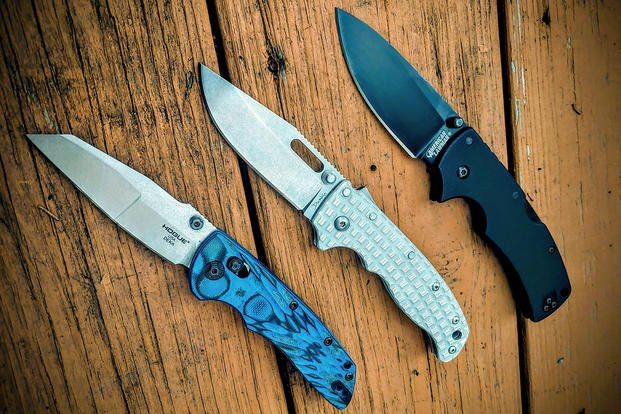As an Amazon associate, Military.com earns from qualifying purchases.
The humble pocket knife is arguably one of the most useful tools I carried with me daily during my service in the U.S. military, and I still carry one today for that exact reason. Keeping a sharp blade in your pocket, whether it’s for utility tasks, self-defense or emergencies, is extremely convenient. I’ve used pocket knives for everything from slicing open MREs to cutting paracord to even taking down saplings, in the case of my old Cold Steel Spartan. The pocket knife has existed in one form or another for thousands of years, and it doesn’t take a knife expert to understand why.
While you probably won’t ever need to resort to using a pocket knife to chop down small trees every day, plenty of regular tasks will likely require a reliable blade. The real challenge, of course, is choosing from the thousands of pocket knives available on the market. Luckily, we’re here to cut through the noise and select the cream of the crop, whether it’s for military or civilian life.
Here’s what we recommend for the best pocket knives available, and why one of these belongs in your everyday (EDC) carry:
Hogue is an American company, well-known for its ergonomic grips for firearms. A lesser-known fact, however, is that the company also makes high-quality knives right here in the USA. Part of the reason that the Deka took the title for ‘Best Overall’ is thanks to the expiration of Benchmade’s Axis lock patent in 2018; the Deka features Hogue’s own take on the iconic crossbar lock, with a few improvements. The main weak point of the Axis lock is the Omega springs, which have been known to occasionally break from use. Hogue outsourced its Omega springs to Wolff Gunsprings, which are known for their strength.
Designed by Marine veteran Allen Elishewitz, the Deka is available in various configurations, including both FRN and G10 handles, stonewashed or Cerakoted blade finishes, and either premium CPM 20CV or popular MagnaCut steel. It’s the lightest knife on this list, coming in at a featherweight 2.1 ounces, thanks to its thin blade and lightweight handle construction. Despite its high quality control, quality materials and stronger lock, the Deka is notably less expensive than its main competitor, the Benchmade Bugout. It’s no surprise that it earned the title of “Bugout Killer.”
Product Specs:
- Blade length: 3.25 inches
- Blade material: MagnaCut or CPM 20CV
- Blade finish: Stonewash or Cerakote
- Handle material: FRN or G10
- Blade shape: Clip point
- Pivot type: Phosphor-bronze washers
- Lock type: ABLE Lock
- Weight: 2.1 ounces
Pros:
- Premium steel options allow you to choose your preferred balance of edge retention, toughness and corrosion resistance.
- Ergonomic handles are slim and incredibly lightweight.
- Upgraded Wolff springs increase lock strength.
- Made in the USA
Cons:
- Thinner blade isn’t great for prying.
- Warranty isn’t quite as good as Benchmade’s.
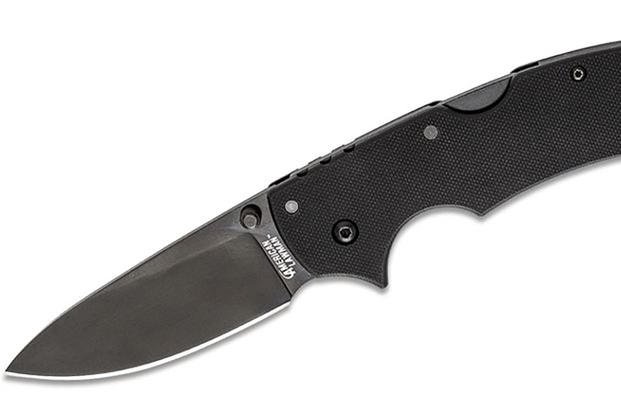
Designed by respected knife-designer Andrew Demko, the Cold Steel American Lawman features his stereotypically comfortable ergonomics, with a generous finger choil that allows you to choke up on the blade for finer work such as whittling, feather-sticking or peeling an apple. The slightly hollow-ground blade is thick enough for most tasks, while still remaining “slicey,” and is made from premium S35VN steel.
The blade is also coated in DLC (diamond-like coating), which protects the blade from wear and corrosion while also letting you cut through materials with less resistance due to reduced friction. To top it off, it’s equipped with Demko’s Tri-Ad lock, which is arguably the strongest, toughest lock on the market. At this price point, what more could you ask for?
Product Specs:
- Blade length: 3.5 inches
- Blade material: CPM S35VN
- Blade finish: DLC
- Handle material: G10
- Blade shape: Drop point
- Pivot type: Phosphor-bronze and Teflon washers
- Lock type: Tri-Ad
- Weight: 4.5 ounces
Pros:
- S35VN steel has excellent edge retention and corrosion resistance.
- Textured, ergonomic G10 scales provide excellent grip.
- The DLC coating is extremely rust/wear resistant.
- Indomitable Tri-Ad lock
Cons:
- Stiff pocket clip
- Tri-Ad locks can be too strong for some people.
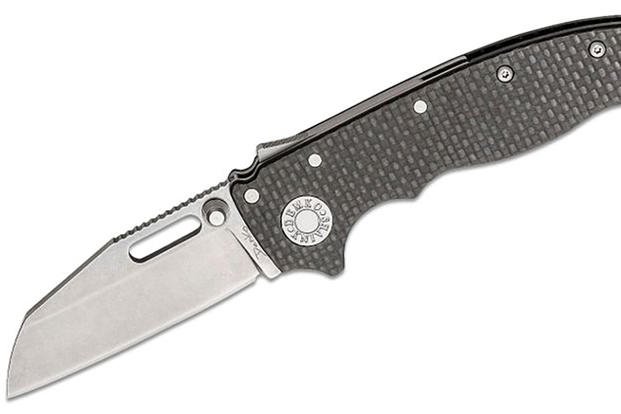
The Demko AD20.5 debuted in 2021 and was such a hit that the supply couldn’t keep up with the demand for months — and honestly, it’s easy to see why.
The AD20.5 features Andrew Demko’s latest lock design, the Shark-lock, which resembles a shark fin. The Shark-lock is Demko’s magnum opus and is the culmination of decades of lock designs, including the Ram Safe Lock, the Scorpion lock and, of course, the famed Tri-Ad lock. The Shark-lock is stronger than the Scorpion lock and easier to manipulate than the Tri-Ad lock, all while having been tested to withstand 875 inches/pounds of torque. For context, that’s more than double the minimum torque spec of an M4 barrel.
The AD20.5 is available in multiple configurations, including both a clip point and Wharncliffe (aka “shark foot”) blade profiles. While the standard handles are made from Grivory, there are other material options, including G10, Ultem and titanium. On top of all that, it’s available in a wide range of blade steels, depending on your needs and budget; the standard version comes in either AUS10 or K110 (D2), with more premium steels such as CPM S35VN, 3V, and 20CV also available. Concerned about rust? The company even offers a DLC option.
We’ve tested and carried the AD20.5 for more than two years, and it’s quickly become one of our favorite Demko designs, thanks to its strong lockup, sturdy blade, ergonomic handle and intuitive design. Regardless of what utilitarian undertaking you might have in mind, we’re sure that you’ll love the AD20.5, too.
Product Specs:
- Blade length: 3.18 inches
- Blade material: D2 or AUS10
- Blade finish: Stonewash or DLC
- Handle material: Grivory
- Blade shape: Clip point or Wharncliffe
- Pivot type: Bearings
- Lock type: Shark-lock
- Weight: 3.6 ounces
Pros:
- Wide range of configurations to meet your needs
- Excellent ergonomics and diamond-textured handle ensure a solid grip.
- Inexpensive
- Shark-lock is incredibly strong despite being easy to manipulate.
Con:
- Jimping on the shark “fin” can be a little aggressive initially.
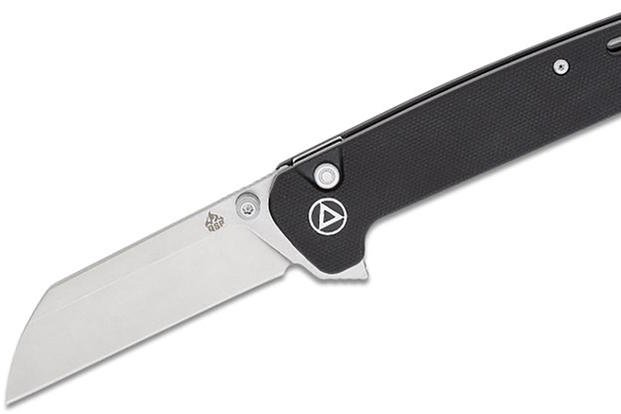
One of the cheapest models we’ve tested, the QSP Penguin definitely holds up to the company’s motto of “Quality, Service and Price.” The base model is available in D2 steel with either satin or stonewashed finishes, with multiple handle material options including micarta, G10, brass, copper, titanium and carbon fiber. If you want more corrosion resistance, they also offer higher-end versions in premium stainless steels such as 14c28n,154CM, M390 or 20cv.
We’ve tested two variants of the Penguin, with the first being in D2 steel with copper handle scales, and the second being a KnivesPlus exclusive in M390 steel with scales made from denim micarta. They both had fairly consistent edge grinds, with good fit and finish. The sheepsfoot blade is small enough to be inconspicuous and legal in most states, while excelling at most EDC things. For the price, you definitely won’t be disappointed.
Product Specs:
- Blade length: 3.125 inches
- Blade material: D2
- Blade finish: Satin
- Handle material: Micarta
- Blade shape: Sheepsfoot
- Pivot type: Copper washers
- Lock type: Linerlock
- Weight: 3.17 ounces
Pros:
- Inexpensive
- Available in wide range of materials and finishes
- Premium versions available
- Utilitarian design works well as a box cutter.
Cons:
- Small handle may not be comfortable for large hands.
- D2 steel is less corrosion resistant than the other steels on this list.
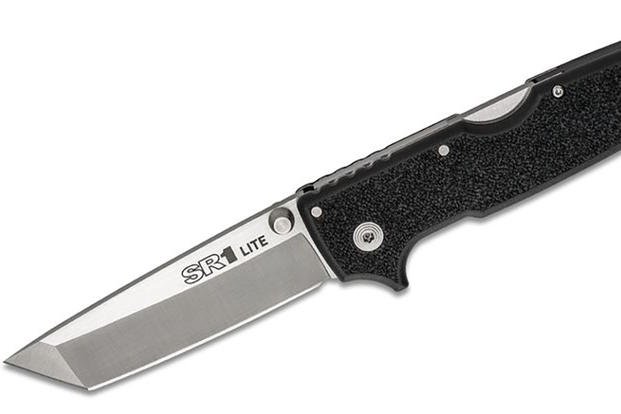
Ever sit and think to yourself, “Man, I really wish I had an ergonomic brick”? The Cold Steel SR1 has you covered. Everything about this knife is overbuilt, from the hardened steel liners reinforcing the G10 handle, to the Tri-Ad lock, all the way to the four-inch-long blade, made from premium CPM S35VN steel. With a spine thickness of 5mm, this blade is more than capable of performing many camping/fieldcraft tasks, while still being thin enough to perform EDC tasks thanks to its saber-grind. The blade also features a crisp 90° spine that’s perfect for striking on a ferro rod.
Despite the handle’s blocky appearance, it’s very comfortable and secure in the hand. This is largely thanks to the curved areas at the front and back of the grip, which prevent your hand from sliding either forward or backward. The textured G10 handle scales further cement your grip, ensuring a firm grasp even in the worst conditions. Whether you’re building a feather-sticking, batoning wood or skinning game, the SR1 has your back.
Product Specs:
- Blade length: 4 inches
- Blade material: CPM S35VN
- Blade finish: Satin
- Handle material: G10
- Blade shape: Tanto
- Pivot type: Phosphor-bronze and Teflon washers
- Lock type: Tri-Ad
- Weight: 7.2 ounces
Pros:
- S35VN steel has excellent edge retention and corrosion resistance.
- Textured, ergonomic G10 scales provide excellent grip.
- Indomitable Tri-Ad lock
Cons:
- Stiff pocket clip
- Tri-Ad locks can be too strong for some people.
The Best of the Rest
There’s a lot of other awesome pocket knives that didn’t make the cut here, either due to them being too niche or being part of a different subcategory of knives.
First, when it comes to pocket knives, there’s always the option of going with a solid multitool instead. Some of these include the Leatherman M.U.T., which has been a favorite of EOD guys for years, and the Leatherman Charge, which is a more EDC-minded option (unfortunately, multitools are a large category that warrant their own article).
For self-defense, we recommend the Cold Steel Black Talon 2 with the serrated edge, as it’s a proven design that is purpose-built for one thing only. Sure, it’s not your trusty U.S. Marine Corps Ka-Bar fighting knife, but unfortunately the Ka-Bar doesn’t really qualify as a pocket knife.
Lastly, for those of you who want a knife with a thinner blade for better slicing, we recommend the Spyderco ParaMilitary 2 and Para 3. Just make sure you don’t pry with them, as some users have broken the tips and blades from misuse.
Choosing the Right Pocket Knife
Choosing which pocket knife to buy can be daunting, but luckily we’ve broken it down for you. Regardless of what knife you’re looking at or what the intended use is, there are three main things to look at: the blade, the handle and the locking mechanism.
Blade
Undeniably the primary feature that makes a knife, well, a knife, blades come in countless sizes and shapes. Bigger tasks need bigger blades, while those same large blades would be more of a hindrance than help for smaller tasks. In general, you’ll want a blade that is between 3-3.5 inches long, depending on the local laws for your area. Thicker blades are tougher, but tend to not cut as easily. The same goes for the edge: Wider, obtuse edges are tougher and more resistant to chipped or rolled edges, while more acute edges cut easier and have better edge retention.
Different blade shapes can make a noted difference depending on what tasks you encounter. Pocket knives made for daily use typically have drop point blades, but you’ll also commonly see clip point and tanto blade shapes, all of which have their own advantages and disadvantages. Clip points have some of the thinnest tips, making them great at piercing, whereas tantos have thicker tips that are reinforced to improve toughness. Drop points are in many ways a jack of all trades, falling in between tantos and clip points; they have the advantage of a tougher tip than clip points while still having better penetration than most tantos.
While many people simply look at the price, ergonomics or overall aesthetics when buying a knife, it’s important to pay attention to what the blade is made from. For most pocket knives, you’ll find that a quality stainless steel is your best bet. Most modern stainless steels offer excellent corrosion resistance while also having better toughness, edge retention and grain structure than the no-name stainless steels of yesteryear. Modern, quality stainless steels include S35VN, S30V, 20CV, M390, 154CM, MagnaCut and many, many others. In short, if the blade doesn’t say what type of steel it is, or only says something ambiguous such as “stainless steel” or “surgical stainless,” it’s best to avoid them.
Handle
The ergonomics and materials used to make a knife handle make a big difference. Poor ergonomics can result in “hot spots” that become painful during extended use, while good ergonomics actually aid your grip by preventing your hand from sliding forward onto the blade (or sliding backward and losing your grip altogether). For materials, there are options such as wood and rubber that can degrade over time due to moisture, temperature, chemicals and other things. Metal handles are somewhat common, but can be slick if they aren’t textured properly, and can have issues with oxidation or galvanic corrosion. Our recommendation for handle materials includes Grivory, FRN, G10 and Micarta due to their durability and excellent resistance to moisture, temperature, chemicals and corrosion/oxidation.
Lock
People often say, “You don’t need a lock on your knife if you’re using it the right way!” Maybe, but most people don’t use their knives the “right way.” While we don’t recommend prying or batoning with your knife, the fact remains that many people will do just that. Having a lock on your knife helps prevent the blade from accidentally closing on your fingers, whether due to hard use or simply oversight. A lot of locking mechanisms are out there, and they all have their own advantages and disadvantages.
When choosing a lock, the main qualities to look for are strength, ease of use and whether it’s ambidextrous. For a solid medley of all three characteristics, crossbar-style locks (such as the Axis lock or ABLE lock) and the Shark lock offer arguably the most balanced blend, as they’re very strong while remaining easy to actuate with either hand. Locks like liner locks and frame locks are common as they’re fairly cheap to manufacture, and are typically easy to actuate and disengage; however they’re not as strong as crossbar-style locks and are typically right-handed. On the complete opposite side of the spectrum, we have the Tri-Ad lock, which is arguably the strongest lock design on the market, and is ambidextrous; however, some people with less hand strength can struggle unlocking it.
About These Product Recommendations
I’m what you could call a “knife nerd,” and I have had an interest in both blades and working with metal for as long as I can remember. That fascination has translated into years of hands-on experience when it comes to picking the best knife for any job. Most of my five years in the Marine Corps was spent honing and repairing my buddies’ blades, and I’ve done everything from a blacksmith apprenticeship to reviewing and recommending knives for my fellow U.S. service members and veterans.
When it comes to these recommendations, I have personally owned, used or worked on every single knife on this list, as well as scores of others that didn’t make the cut. Similarly, no outside entities or corporate overlords had any input into the composition of these recommendations; they are entirely based on my expertise and nothing more.
Want to Know More About the Military?
Be sure to get the latest news about the U.S. military, as well as critical info about how to join and all the benefits of service. Subscribe to Military.com and receive customized updates delivered straight to your inbox.
Story Continues
Read the full article here

